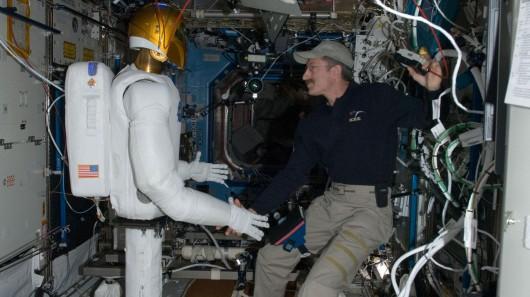 By Nathan Wong
By Nathan Wong
Part four of a five-part series about going back to the Moon, by Google Lunar X PRIZE technical consultant Nathan Wong.
In the past three articles we have talked about getting to the Moon, the challenges once you are there, and the benefits of going. In this article we will talk about some of the advances in robotics that are currently happening that may make future lunar and planetary exploration more successful. Robotics and artificial intelligence are very popular fields of research right now with many ideas on what will be the next big advancement. I will look at five of these upcoming fields: swarm robotics, human robotic interaction, biomimetics, telerobotics, and adaptive robotics.
Swarm Robotics
The basic idea behind swarm robotics is that using multiple robots that work together can accomplish more than the same robots working individually. The space industry is currently looking at using swarm robotics for satellites flying in formation flight to create a virtual larger aperture using the distance between satellites instead of using a single satellite. The satellites in this swarm must calculate and maintain a precise distance from all other satellites in the formation, similar to the video below showing multi-rotor vehicles in formation flight.
Additionally swarm robotics can be used for surface exploration. If you have only one robot and it fails your mission is done. If you have multiple robots and one fails you can still accomplish your objectives. An example of this can be seen in the next video where a swarm of robots pull a small child. A swarm of robots could move heavy rocks, cross gaps, or climb slopes that a single robot could not.
Human Robotic Interaction
Human robotic interaction is as it sounds; how humans and robots interact. The thought is that if you can leverage both the advantages of robots and humans together, you can accomplish more. A great example of this is Robonaut 2, which is a humanoid robot that was sent to the International Space Station (ISS). Currently Robonaut 2 is performing basic tests to see how it operates in microgravity, but one of the goals of the program is to use Robonaut 2 to perform tasks on the ISS. Currently human astronauts have to spend time cleaning the ISS, but one day Robonaut 2 might float around the station performing the cleaning, just like Rosie from the Jetsons, allowing the human crew more time to perform more research.

Biomimetics
Animals in nature have been evolving for millions of years to become suited to their environment. Biomimetics is a field that uses this adaptation as an inspiration for design. A very simple example of this is fins used for diving. The fins provide a larger surface area, just as the tail fins of fish help propel them through the water. This same principle can be applied to robotics. Boston Dynamics is well known for their "Big Dog" walking robot, but they also have a robot that is designed to run like a cheetah at up to 18 miles per hour.
Telerobotics
Telerobotics is the control of a robot remotely. Currently, one of the most promising applications of telerobotics is use in medical surgeries. A world-class surgeon could operate on anyone, anywhere in the world eliminating the need to travel physically to the doctor's location. Systems like this could also be applied to space in the medical sector such as a telerobotic surgery station on the Moon. It can also be used to put robots in an area that may be too dangerous for humans to go, but real time human decision-making is favored over autonomous robotics.
NASA currently has the Surface Telerobotics Project where they will look at using astronauts on the ISS to telecontrol robots on the Earth. They are also looking to expand this to the Earth Moon Second LaGrange point to explore the far side of the Moon. Looking even further out, this type of system could be used for near real time robotic exploration of Mars from a Martian moon.
Adaptive Robotics
Adaptive robotics refers to a type of robot that is adaptable and deformable to suit environmental requirements. An example of this is tensegrity robotics which are composed entirely of interlocking rods and cables. These rods and cables are arranged in such a way that any force is distributed to all of the members instead of just one. This can increase reliability and allows for increased potential motion. The main benefit of tensegrity robotic structures for space is that they can be light weight and easily launched. An animation of how this tensegrity structure would move can be seen in the video.
The basic concept of transformable and adaptable robotics can also be applied to a more traditional structure. The next video shows a robot that can either walk, or roll depending on what the environment requires.
Conclusion
Advances in robotics are happening at a truly amazing rate. The capabilities that we have now compared to 10 years ago are staggering and the trend of increasing capabilities will extend into the future. Think about the entrants to the Google Lunar X PRIZE as the first generation of robotics, how will their designs and capabilities change as they send the second, third, ... generation of vehicles to the Moon? Maybe they will use some of the techniques talked about in this article and maybe they will use something entirely new and different. The next and last blog post in this series will talk about the sustainability of going back to the Moon.
Visit X PRIZE at xprize.org, follow us on Facebook, Twitter and Google+, and get our Newsletter to stay informed.
This blog post is brought to you by Shell, our Exploration Prize Group sponsor.